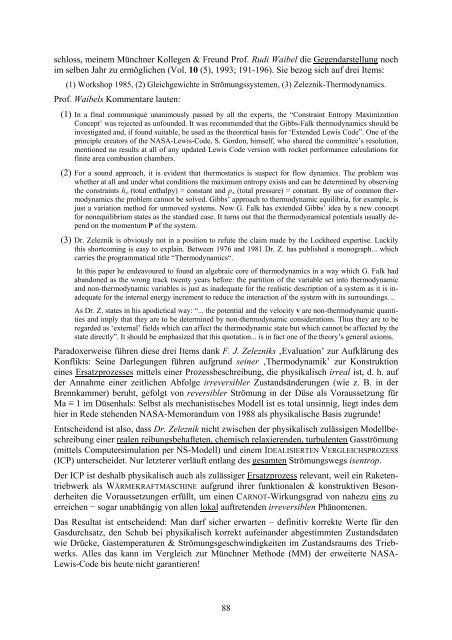PDF zum Download - Tim Boson / Condor
PDF zum Download - Tim Boson / Condor
PDF zum Download - Tim Boson / Condor
Erfolgreiche ePaper selbst erstellen
Machen Sie aus Ihren PDF Publikationen ein blätterbares Flipbook mit unserer einzigartigen Google optimierten e-Paper Software.
schloss, meinem Münchner Kollegen & Freund Prof. Rudi Waibel die Gegendarstellung noch<br />
im selben Jahr zu ermöglichen (Vol. 10 (5), 1993; 191-196). Sie bezog sich auf drei Items:<br />
(1) Workshop 1985, (2) Gleichgewichte in Strömungssystemen, (3) Zeleznik-Thermodynamics.<br />
Prof. Waibels Kommentare lauten:<br />
(1) In a final communiqué unanimously passed by all the experts, the “Constraint Entropy Maximization<br />
Concept’ was rejected as unfounded. It was recommended that the Gibbs-Falk thermodynamics should be<br />
investigated and, if found suitable, be used as the theoretical basis for ‘Extended Lewis Code”. One of the<br />
principle creators of the NASA-Lewis-Code, S. Gordon, himself, who shared the committee’s resolution,<br />
mentioned no results at all of any updated Lewis Code version with rocket performance calculations for<br />
finite area combustion chambers.<br />
(2) For a sound approach, it is evident that thermostatics is suspect for flow dynamics. The problem was<br />
whether at all and under what conditions the maximum entropy exists and can be determined by observing<br />
the constraints h∞ (total enthalpy) = constant and p∞ (total pressure) = constant. By use of common thermodynamics<br />
the problem cannot be solved. Gibbs’ approach to thermodynamic equilibria, for example, is<br />
just a variation method for unmoved systems. Now G. Falk has extended Gibbs’ idea by a new concept<br />
for nonequilibrium states as the standard case. It turns out that the thermodynamical potentials usually depend<br />
on the momentum P of the system.<br />
(3) Dr. Zeleznik is obviously not in a position to refute the claim made by the Lockheed expertise. Luckily<br />
this shortcoming is easy to explain. Between 1976 and 1981 Dr. Z. has published a monograph... which<br />
carries the programmatical title “Thermodynamics“.<br />
In this paper he endeavoured to found an algebraic core of thermodynamics in a way which G. Falk had<br />
abandoned as the wrong track twenty years before: the partition of the variable set into thermodynamic<br />
and non-thermodynamic variables is just as inadequate for the realistic description of a system as it is inadequate<br />
for the internal energy increment to reduce the interaction of the system with its surroundings. ..<br />
As Dr. Z. states in his apodictical way: “... the potential and the velocity v are non-thermodynamic quantities<br />
and imply that they are to be determined by non-thermodynamic considerations. Thus they are to be<br />
regarded as ‘external’ fields which can affect the thermodynamic state but which cannot be affected by the<br />
state directly”. It should be emphasized that this quotation... is in fact one of the theory’s general axioms.<br />
Paradoxerweise führen diese drei Items dank F. J. Zelezniks ‚Evaluation’ zur Aufklärung des<br />
Konflikts: Seine Darlegungen führen aufgrund seiner ‚Thermodynamik’ zur Konstruktion<br />
eines Ersatzprozesses mittels einer Prozessbeschreibung, die physikalisch irreal ist, d. h. auf<br />
der Annahme einer zeitlichen Abfolge irreversibler Zustandsänderungen (wie z. B. in der<br />
Brennkammer) beruht, gefolgt von reversibler Strömung in der Düse als Voraussetzung für<br />
Ma ≡ 1 im Düsenhals: Selbst als mechanistisches Modell ist es total unsinnig, liegt indes dem<br />
hier in Rede stehenden NASA-Memorandum von 1988 als physikalische Basis zugrunde!<br />
Entscheidend ist also, dass Dr. Zeleznik nicht zwischen der physikalisch zulässigen Modellbeschreibung<br />
einer realen reibungsbehafteten, chemisch relaxierenden, turbulenten Gasströmung<br />
(mittels Computersimulation per NS-Modell) und einem IDEALISIERTEN VERGLEICHSPROZESS<br />
(ICP) unterscheidet. Nur letzterer verläuft entlang des gesamten Strömungswegs isentrop.<br />
Der ICP ist deshalb physikalisch auch als zulässiger Ersatzprozess relevant, weil ein Raketentriebwerk<br />
als WÄRMEKRAFTMASCHINE aufgrund ihrer funktionalen & konstruktiven Besonderheiten<br />
die Voraussetzungen erfüllt, um einen CARNOT-Wirkungsgrad von nahezu eins zu<br />
erreichen − sogar unabhängig von allen lokal auftretenden irreversiblen Phänomenen.<br />
Das Resultat ist entscheidend: Man darf sicher erwarten ‒ definitiv korrekte Werte für den<br />
Gasdurchsatz, den Schub bei physikalisch korrekt aufeinander abgestimmten Zustandsdaten<br />
wie Drücke, Gastemperaturen & Strömungsgeschwindigkeiten im Zustandsraums des Triebwerks.<br />
Alles das kann im Vergleich zur Münchner Methode (MM) der erweiterte NASA-<br />
Lewis-Code bis heute nicht garantieren!<br />
88


